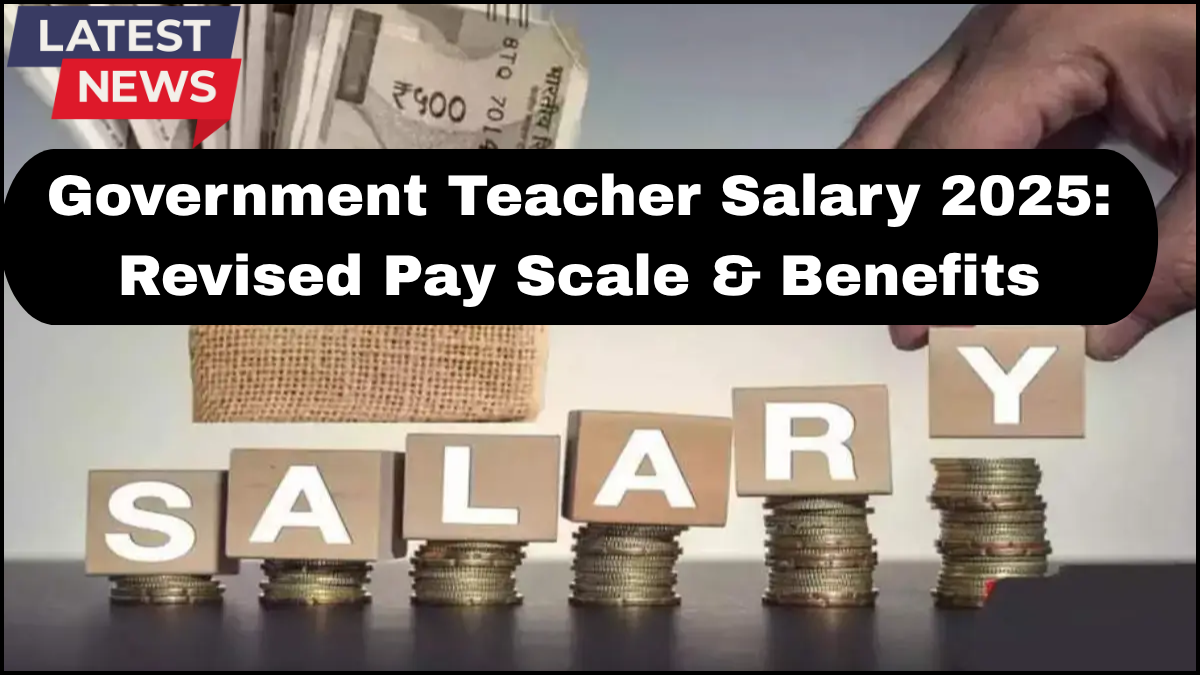The role of government school teachers remains one of the most respected and stable career choices in India. With the new year, significant updates have been introduced to the Teacher Salary 2025 structure, bringing changes to the Government Teacher Pay Scale, allowances, and other financial benefits. These revisions aim to ensure fair compensation for educators while attracting more qualified candidates to the profession.

Below is an in-depth breakdown of the revised pay structure, associated benefits, and how these changes affect teachers across different grades and levels.
Revised Government Teacher Pay Scale 2025
The Teacher Salary 2025 has been updated in line with inflation adjustments and the latest government recommendations. The new pay scale varies depending on the grade, teaching level, and years of service.
-
Primary School Teachers:
Under the revised structure, primary school teachers now earn a basic pay starting from ₹35,400 per month, up from the previous ₹29,200. This increment is accompanied by increased Dearness Allowance (DA) and House Rent Allowance (HRA), significantly improving take-home pay. -
Trained Graduate Teachers (TGTs):
TGTs, responsible for teaching higher classes, have a starting basic pay of ₹44,900, reflecting a steady rise from earlier pay scales. This boost ensures better financial motivation for mid-level teaching positions. -
Post Graduate Teachers (PGTs):
PGTs enjoy one of the highest government teaching pay scales, starting at ₹47,600, with senior positions crossing ₹1,50,000 per month when allowances and increments are added.
These updates to the Government Teacher Pay Scale are part of the Seventh Pay Commission recommendations, with further state-specific revisions in some regions.
Allowances and Additional Benefits
One of the main attractions of being a government teacher is the package of allowances that come in addition to the basic salary. Under the Teacher Salary 2025 revision, these allowances have also been enhanced.
-
Dearness Allowance (DA):
Increased to keep pace with inflation, DA now makes up 42% of the basic pay in most states. -
House Rent Allowance (HRA):
Varies between 8% to 24% of the basic salary depending on the city’s classification (X, Y, or Z category). -
Transport Allowance:
Teachers in urban centers receive higher transport allowances to offset commuting expenses. -
Medical Benefits:
Comprehensive healthcare coverage for teachers and their families, including reimbursement for medical expenses in government-approved hospitals. -
Pension and Retirement Benefits:
Guaranteed pension under the National Pension Scheme (NPS) and gratuity payments ensure financial stability post-retirement.
Annual Increments and Career Progression
In the Government Teacher Pay Scale, annual increments play a key role in salary growth. Teachers receive a yearly increase in basic pay, along with opportunities for promotions based on performance, qualifications, and experience.
For example:
-
A primary teacher who joins at ₹35,400 can, within a decade, move up to ₹50,000+ basic pay through increments and promotions.
-
TGTs and PGTs can progress to administrative or principal-level positions with significantly higher pay and responsibilities.
Impact of Salary Revision on Recruitment
The revised Teacher Salary 2025 has a direct effect on attracting skilled educators. Competitive pay, coupled with job stability and pension benefits, makes government teaching positions highly sought-after. This is expected to improve the overall quality of education, as better pay packages encourage more candidates to pursue B.Ed. and other teaching qualifications.
State-Wise Variations in Pay
While the central government sets a general pay framework, states have the authority to implement their own variations based on budget capacity and cost-of-living differences. For instance:
-
Delhi government teachers often receive higher HRA due to metropolitan classification.
-
States like Kerala and Maharashtra offer additional festival allowances.
-
Northeastern states provide remote area allowances to encourage teachers to work in rural or difficult terrains.
Key Takeaways
-
Teacher Salary 2025 has seen substantial increments across all levels.
-
Allowances and retirement benefits make the Government Teacher Pay Scale one of the most attractive in the public sector.
-
State-specific variations ensure flexibility and localized adjustments to cost of living.
FAQs on Teacher Salary 2025
Q1: What is the starting salary of a government primary school teacher in 2025?
The starting basic pay is ₹35,400, excluding allowances like DA and HRA.
Q2: Are allowances included in the Government Teacher Pay Scale?
Yes, allowances such as DA, HRA, transport, and medical benefits are provided in addition to the basic pay.
Q3: Does the revised Teacher Salary 2025 apply to all states?
The central pay commission recommendations apply nationwide, but states may adapt the structure based on their own rules.
Q4: How often are government teacher salaries revised?
Major revisions occur with new pay commission reports, generally every 8–10 years, along with periodic DA adjustments twice a year.
Q5: Do government teachers get a pension after retirement?
Yes, most government teachers are covered under the National Pension Scheme, ensuring financial security post-retirement.
click here to learn more